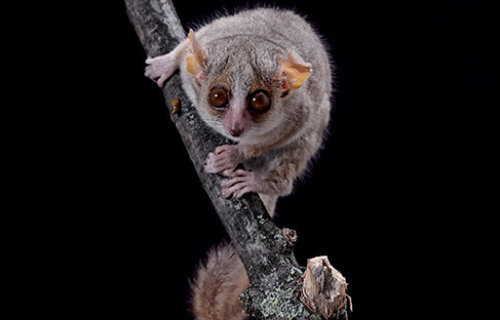
GENEVA, Switzerland — Human sight can be traced back to a tiny mammal that has lived on the island of Madagascar for 55 million years, according to recent research. Scientists say we can thank the gray mouse lemur — the world’s smallest primate — for preserving our vision capabilities over millions of years of evolution.
No bigger than an apple, the gray mouse lemur weighs only two ounces. The endangered animal’s visual system is just as big as that of other primates, irrespective of their size, say scientists. Indeed, more than a fifth of the gray mouse lemur’s brain is dedicated to visual processing, compared to barely three percent of the human brain.
The study by researchers from Switzerland and Germany highlights the gray mouse lemur’s incredible preservation and importance to our daily lives, as well as to the lives of our ancestors in the distant past. Madagascar, an island in the Indian Ocean, has evolved in isolation for 165 million years. As a result, it is home to animals and plants that exist nowhere else.
The international team of scientists involved in the study hopes the finding will inspire efforts to save it.
“This study also highlights the crucial importance of conserving the habitat of primate species such as the mouse lemur, particularly in the forests of Madagascar. These habitats are disappearing at an alarming pace, taking with them precious keys to understanding our own origins,” says lead author Daniel Huber a professor in the Department of Basic Neurosciences at the University of Geneva, in a statement.
What makes the vision of gray mouse lemurs so unique?
Primates process images in front of their eyes, using small computing units located in the visual cortex of their brains, similar to pixels in a digital camera. The visual system of primates has fascinated biologists for more than a century as it is unique among mammals, including rodents.
“As the different primate species cover a wide range of sizes, we were led to wonder whether this basic computing unit scales with body or brain size. Is it simplified or miniaturized, for example, in the world’s smallest primate, the gray mouse lemur?” asks Huber.
In experiments, researchers presented geometrical shapes representing lines of various orientations to lemurs and imaged the activity of their neurons using an optical brain scanner. The repetition of such measurements gradually allowed the researchers to determine the size of the minimal units processing form information.
“We expected to see a unit of tiny size, proportional to the small size of the lemur, but our data revealed they measure more than half a millimeter in diameter,” says Huber.
The researchers compared hundreds of these units in the tiny gray mouse lemur brain with data obtained from the visual circuits of other, much larger primate species. Surprisingly, the basic processing unit was almost identical in size in the mouse lemur as in larger primates including monkeys such as macaques weighing more than 14 pounds, or even bigger primates – such as humans.
Unit arrangement across the brain was also completely indistinguishable, following the same rules with mathematical precision. And the number of nerve cells was equal, too.
Fascinating twist of evolution
Study co-author Fred Wolf, a professor at the Max Planck Institute in Göttingen, Germany, predicted universal mathematical principles would govern visual system evolution a decade ago. Yet even he is still amazed by the degree of invariance. “Fifty-five million years of separation on different continents is a very long evolutionary path to travel,” he says. “I would have expected some mix of general similarity and characteristic differences between species in these neural modules. But the fact of the matter is simply this: It is practically impossible to tell them apart.”
The study sheds fresh light on the origins of primate vision. The unit cannot be compressed or miniaturized. A fixed number of neurons is required to ensure optimal functionality. The fact this unit is so well preserved suggests it evolved very early. When it comes to forming images, our primate ancestors had abilities similar to ours from the start.
“For tiny primate species with excellent vision, such as the mouse lemur, the visual system must hence be relatively large, compared to the size of their entire brain, to accommodate a sufficient number of visual processing units,” adds Huber.
The study is published in the journal Current Biology.
SWNS writer Mark Waghorn contributed to this report.
